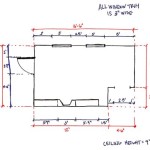Framing interior walls is a straightforward but important task for any construction project. It goes beyond just installing the walls and setting them in place; proper framing ensures that the walls are strong, stable, and aligned correctly. With the right materials and techniques, you can frame your interior walls quickly and accurately.
Gather Necessary Materials
Before starting any framing work, it is important to gather the necessary materials. You will need the following:
- Lumber for the wall framing
- Wall studs
- Nails or screws
- Stud finder
- Level
- Measuring tape
- Hammer
- Drill
Layout the Wall Studs
The first step in framing interior walls is to layout the studs. This is done by measuring and marking the locations of the wall studs on the floor. The studs should be spaced at 16-inch intervals, with the corners of the walls marked with double studs. When marking the stud locations, use a level to make sure that the wall is straight and level.
Install the Bottom Plate
Once the stud locations have been marked, the next step is to install the bottom plate. This is a horizontal piece of lumber that is attached to the floor along the edges of the wall. Use nails or screws to secure it in place. Make sure that the bottom plate is level and aligned with the marks on the floor.
Install the Wall Studs
The next step is to install the wall studs. Start by placing the studs at the marked locations on the bottom plate. Make sure that the studs are aligned with the marks on the floor and are level. Use a stud finder to ensure that the studs are properly located. Secure the studs in place using nails or screws.
Install the Top Plate
Once the wall studs are in place, the next step is to install the top plate. This is a horizontal piece of lumber that is attached to the ceiling along the edges of the wall. Use nails or screws to secure it in place. Make sure that the top plate is level and aligned with the marks on the floor.
Final Touches
The final step in framing interior walls is to check the frame for stability and alignment. Use a level to make sure that the frame is straight and level. If needed, make adjustments to the studs or plates to ensure that the frame is stable and aligned correctly.
With the right materials and techniques, framing interior walls is a straightforward but important task. By following these steps, you can ensure that your walls are strong, stable, and correctly aligned.














Related Posts








